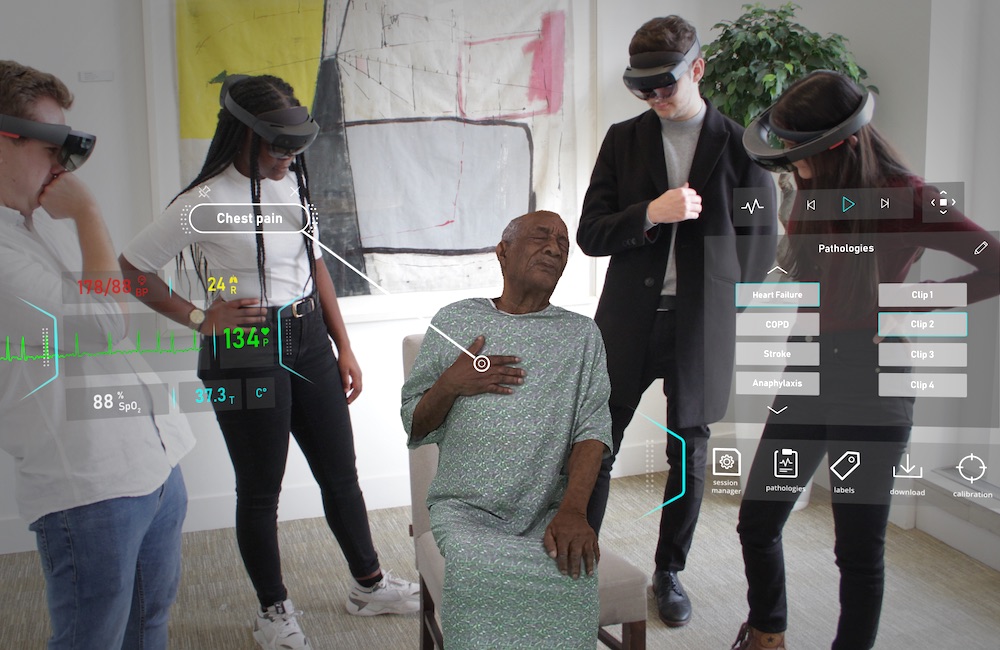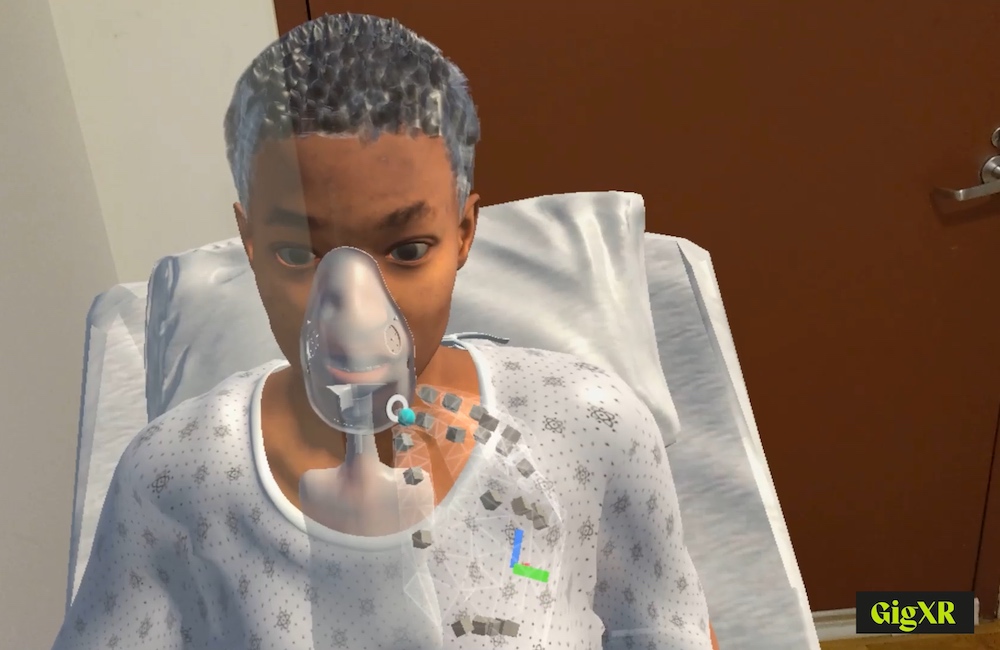GigXR Partners With Leading Medical Education Programs to Develop Healthcare Simulation Metaverse
Healthcare simulation in 2022 has an opportunity to address key challenges facing the industry. Safe-to-fail training provides an ideal environment for learners to practice vital skills ranging from common procedures to improved patient interaction. Learners can practice the real-time judgment, intervention choice, and timeliness required to provide optimal care in both non-acute and acute care scenarios. This HealthySimulation.com article details how GIGXR is utilizing technology to extend innovative clinical simulation scenarios to company partners, increasing clinical simulation possibilities worldwide!
While traditional healthcare simulation methods such as manikins and standardized patients provide excellent training, they also require a significant investment of money, physical space, and faculty hours and are extremely difficult to scale. State of the art clinical simulation manikins are outstanding tools for showing some physical symptoms but can push the six-figure mark and medical simulation centers require extensive amounts of space not only for the clinical simulations themselves (even for a small group of six to seven learners) but for the storage of manikins and other needed materials. Standardized patient programs necessitate finding, hiring, and training people to portray the patients (or faculty time if scenarios are being portrayed by instructors within the program).
GigXR, a global immersive learning provider, uses mixed reality (MR) to create hyper-realistic hologram patients to provide learners at all stages of healthcare training and practice with safe-to-fail scenarios in which to practice key skills. MR also empowers institutions to deliver state-of-the-art simulation in an accessible and scalable way. As MR blends the physical and digital world, learners train in the environment in which they’ll be using those skills, not in an uncustomizable, computer-generated world.
Sponsored Content:
Mixed reality’s hyper-realism not only helps learners interact with simulations, but the technology also allows them to work with the tools and the space that they will likely be using in reality. In addition, because the applications GigXR offers work with the Microsoft HoloLens 2 headset (learners can also access some content through Android or iOS smartphones or tablets), they drastically reduce the space needed for simulations, while enabling instructors to provide the highest-quality training to a larger number of students than is possible with manikin simulation.
Having a platform that hosts mixed reality applications and learning tools opens up new possibilities for how healthcare simulation fits into healthcare curricula, as well as providing the framework for endlessly customizable scenarios that accurately reflect the training needs of a specific group. With MR, programs can expand the role of clinical simulation in training hands-on skills, clinical reasoning, and imparting expertise in acute care or emergency situations.
Mixed Reality & the Future of Medical Education
As the metaverse comes online and the world shifts more towards immersive interaction, MR will become increasingly mainstream and intuitive for learners to use. MR is resource-efficient, which means medical simulations require only one instructor and headsets and therefore can be conducted in a classroom as well as a sim center, or even have learners log on remotely. This enables instructors to broaden the geographic scope of their training, as well as have the ability to reach non-professional learners looking to acquire healthcare skills, such as CPR (required in a wide range of professions) and first aid.
Sponsored Content:
A subsidiary of Northwest Permanente P.C has invested in and partnered with GigXR to develop basic and advanced life support modules, starting with CPR and building on hyper-realistic scenarios with hologram patients.
“Speed, accuracy, and teamwork are critical to providing lifesaving care during a cardiac emergency; training has to be top-quality for every person involved, individually and as a group. Conventional methods such as expensive mannequins cannot simulate the sense of urgency and teamwork of real-life BLS/ACLS – mixed reality adds both an incredible level of realism and collaboration to close critical training gaps. By partnering with GigXR, we’re allowing learners to practice real-time emergency care in the metaverse just as they would as a healthcare professional in the hospital or even as a family member at home.” said Patricia Ramos, MD, MCRP, Medical Director, Center for Innovative Medical Simulation, and Senior Emergency Physician at NWP.
Ramos added that teaching CPR using mixed reality greatly enhances the realism of the scenarios which helps learners better visualize and apply training. He added that, ultimately, it improves overall learning, knowledge retention, and judgment to make learners more confident and proficient in real life.
“For a non-medical professional practicing how to handle these scenarios, which can be incredibly intense and shocking, it is going to make life-altering differences for those suffering a cardiac emergency outside of a hospital or clinical environment. For the medical professional, these MR experiences are going to allow them to enhance their acute care skills in the most hyper-realistic, safe-to-fail environments,” Ramos said.
Dr. Ramos and GigXR will be speaking about the early development of these modules and mixed reality’s impact on training innovation at next week’s IMSH conference on Tuesday, January 18, 2022, at 4 PM Pacific Standard Time.
Mixed Reality & Acute Care Simulation
Showing either patient deterioration of the patient journey throughout a hospital stay can be challenging using manikins and standardized patients. Manikins can be made to show some important symptoms of a given pathology, but often can’t show evolving scenarios without pausing the medical simulation to add moulage. Standardized patients can show symptoms in a more realistic way but don’t allow for the use of diagnostic tools (as the “patients” are not ill and therefore cannot replicate symptoms such as impaired breathing or cardiac abnormalities).
Manikins can be made to reflect some, but not all, symptoms of deterioration which is where mixed reality’s ability to show disease progression brings added value, realism, and a sense of timeliness to training. GigXR is co-creating an evidence-based acute care simulation with the University of Cambridge and Cambridge University Hospitals NHS Trust for multi-professional training including medical students, nurses, and doctors seeking to enhance their skills in clinical practice. The holographic patients can show deterioration and recovery more accurately than other modalities and can also enhance healthcare simulation using manikins.
“Mixed reality not only allows us to create patient holograms that will have realistic medical responses to interventions, but also merges the latest advancements in hardware devices, software, remote capabilities, and expertise, to scale access to cutting-edge medical knowledge and training tools,” said Arun Gupta, Director of Postgraduate Education, Cambridge University Health Partners. The first module created by this partnership will cover respiratory conditions.
Mixed Reality & Practical Skills
Practice makes…perfect? Not quite, but experience counts. For preclinical medical students, MR offers a way to practice the manual skills needed for common procedures such as central line placement or abscess drainage. Due to the nature of the technology, students can repeat the procedure as often as they need to in MR and on-demand. GigXR partnered with Michigan Medicine to create the XR Procedure Training Suite to help students prepare for practice on manikins and eventual patient care.
“Mixed reality places the holographic patient right in front of the learner to visualize critical techniques, such as aspirating an abscess and line placement, while still maintaining the collaborative, hands-on experience of standing around the patient with other learners. Being able to safely practice skills and techniques outside of a medical simulation lab, or in any environment, with high-fidelity, true-to-life MR patients brings tremendous value that could accelerate learner readiness and preparedness for the clinic,” said Dr. Mark Cohen, a Professor of Surgery, Pharmacology, and Biomedical Engineering at Michigan Medicine.
That could pay off in the real world. “Our goal and impact for creating the XR Procedure Training Suite are not just in accelerating skills development, but in empowering instructors to provide training that results in more efficient and safer patient care that ultimately would lead to improved patient outcomes,” added Cohen.
Over the past 12 months, GigXR has released, in partnership with Elsevier, the anatomy application HoloHuman 2.0 and added more functionality to its other flagship product, the clinical reasoning nursing simulation HoloPatient. The company has also expanded among the life sciences category supported by AFWERX and in partnership with the United States Airforce Academy. Its remote SaaS platform has also allowed instructors to shift seamlessly between remote and in-person classes.
About GigXR
GigXR is a provider of reality (XR) learning systems for instructor-led teaching and training that enhances learning outcomes for medical and nursing schools, hospitals and higher education, and the Department of Defense. GigXR’s Immersive Learning System includes a growing catalog of mixed reality applications that run on a robust platform, designed to break through the limitations of conventional 2D learning resources, by placing true-to-life 3D healthcare simulations and teaching tools in a collaborative physical space using the Microsoft HoloLens 2.
GigXR’s flagship products, HoloPatient and HoloHuman, use volumetric video capture and hyper-realistic 3D models to create safe-to-fail environments in which medical and nursing students can practice vital diagnostic, communication, and clinical reasoning skills. GigXR is headquartered in Los Angeles, CA with global customers on five continents.
Learn More About GigXR
Sponsored Content:
















